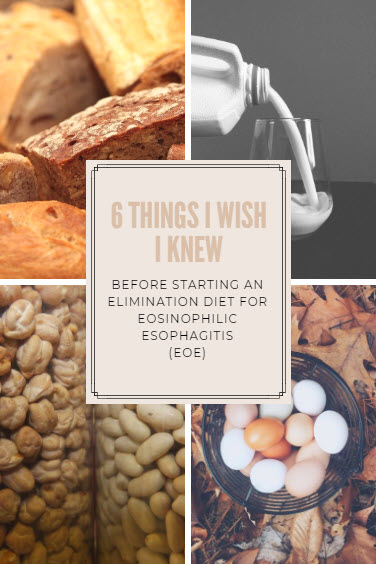 Elimination Diet for Eosinophilic Esophagitis, is written by our guest blogger Alexia Beauregard. Alexia is a food allergy specialist dietitian who also specializes in eating and feeding disturbances and is based in Greenville, South Carolina. She loves working with food allergy families to help make food fun again. Alexia believes that eating should be one of the basic joys in life and wants everyone to be able to enjoy whatever foods they can.
Elimination Diet for Eosinophilic Esophagitis, is written by our guest blogger Alexia Beauregard. Alexia is a food allergy specialist dietitian who also specializes in eating and feeding disturbances and is based in Greenville, South Carolina. She loves working with food allergy families to help make food fun again. Alexia believes that eating should be one of the basic joys in life and wants everyone to be able to enjoy whatever foods they can.
Start getting ready to implement the full elimination diet for Eosinophilic Esophagitis gradually
You do not have to run to the grocery immediately following the appointment in which you are told to avoid milk, wheat, and soy (for example) to try to find alternative products. You have time to process that information and figure out how to make it work. It is important to determine what foods your child relies on the most for calories, protein, vitamins and minerals and what substitutes are available. As with any diet change, slow and steady wins the race.
Pick one or two foods at a time that you are going to change and experiment with alternative allowable foods.
Try new cooking techniques. Also, take this time to inform school, daycare, and anyone that may be involved in feeding your child about these dietary changes. The important thing to remember is that you or your child needs to be on your full elimination diet for at least 8 weeks before getting another endoscopy to determine if diet therapy is helping. The faster you begin to implement the full elimination diet, the faster you can start the countdown to your next endoscopy, and the faster you may be able to expand your diet again.
It will take more time if you are not prepared for your elimination diet for Eosinophilic Esophagitis
Be prepared to spend more time finding and preparing foods. The good news is that once you find your set “go to” foods at your usual grocery store or a grocery store new to you, the amount of time required will decrease. Commit the time to finding as many alternative allowable foods as you can at the beginning of your elimination diet period. It will take more time to plan for travel or even going out to dinner on a Friday night.
Remember, that this time is an investment in your or your child’s safety and can help prevent accidental exposure. It is heartbreaking to hear stories of a family that is 6 weeks into their 8 week elimination diet only to learn that they included a food that had milk in it because they did not take the time to fully read a food label. When this happens, the elimination diet clock has to start over. Time spent finding and preparing allowable food is time well spent.
You can select the start date
You and your doctor agree that your child should start an elimination diet to determine if that will help reduce their EoE symptoms. It’s beneficial to start when the diet will be successful. For example during Fall months, all you can think about is Halloween, Thanksgiving, and Christmas and how to manage this diet around the holidays. I tell the families I work with to pick an 8-week time frame when they know they will have the highest likelihood for success. Some families may choose to use medication until they start their diet while others want to jump in and think of a milk free and wheat free Thanksgiving as a good challenge. However you feel about the diet, pick a time to implement the diet when you know you can be successful.
It does not have to cost more
Yes, alternative products such as wheat free bread are more expensive. That is an undeniable fact. But, the diet does not have to include bread made from specialty flours. Think outside the sandwich when it comes to lunch. Single ingredient whole foods (think whole chicken) actually costs less per pound then chicken already cut up and sold in marinade. Grocery stores will charge more for items in which they do most of the prep work. Single ingredient foods are going to be a safer choice by decreasing the risk of accidental exposure to foods/ingredients that need to be avoided. Some families have found that purchasing other staple household items online is cheaper and provides more money in their budget for food items that may be more expensive. Get creative with how you shop and meal plan. Remember point #2…it will take more time at first.
You are not alone
Any medical diagnosis can feel very isolating for the person with the illness or for the entire family. The good news is that in our highly connected and wired world it has never been easier to find people to connect with that are living with a similar situation. Organizations such as APFED have a tremendous amount of valuable information on their website to not only manage an elimination diet but can also help find a local support group. Other websites like Inspire can help connect you with other EoE families in an online community. Families that have done this diet are a source of information for products, restaurants, hotels, and food free activities. This is a hard diet but it can be done. Find support to help make this challenging time a little bit easier for your family. EoE is not something that a family has to endure alone.
You or your child may not feel any differently
The truth is that you or your child may not feel any differently on this diet. Some EoE patients have very pronounced symptoms and feel much better when they avoid their trigger foods. Some people have much more subtle symptoms and may not feel any differently on this diet. Even in the absence of symptoms, it is important to follow the elimination diet. Remember, the goal of this diet is to prevent damaging inflammation in your esophagus and find the foods that cause the body to react in this way.
The goal is to avoid those EoE symptoms that occur inside and outside the esophagus. Avoiding trigger food is only one step of many. on it

Alexia Beauregard is a Registered Dietitian
The inspiration for this blog is based on her extensive experience working with the families of patients diagnosed with EoE.
Please be sure to talk to members of your child’s healthcare team to determine if this information is appropriate for your child.
She works with families in an outpatient setting and also teaches college courses.
Her professional organization memberships include:
-
-
-
-
-
- The American Academy of Allergy,
- Asthma and Immunology (AAAAI),
- American College of Allergy
- Asthma and Immunology (ACAAI)
- The Council for Pediatric Nutrition Professionals (CPNP)
- International Network for Diet and Nutrition in Allergy (INDANA).
- You can find her on her Facebook page www.facebook.com/thrivewithfoodallergy or in her private practice–Seagrass Nutrition & Therapy (www.seagrassnutrition.com).
- Has three children and husband keep her pretty busy at home. The Beauregards love sailing, biking, hiking, and just being outside in general.
-
-
-
-






